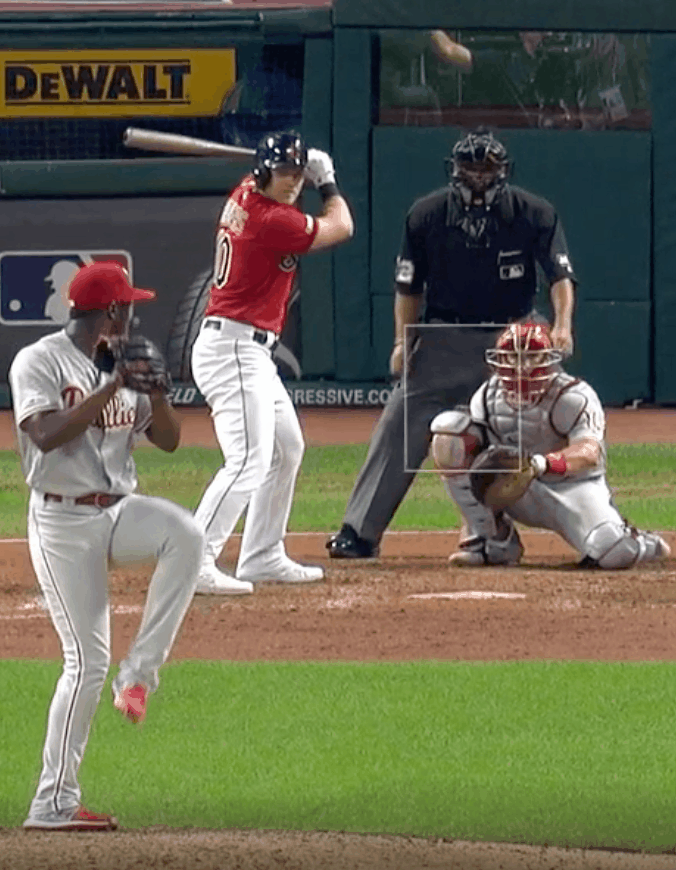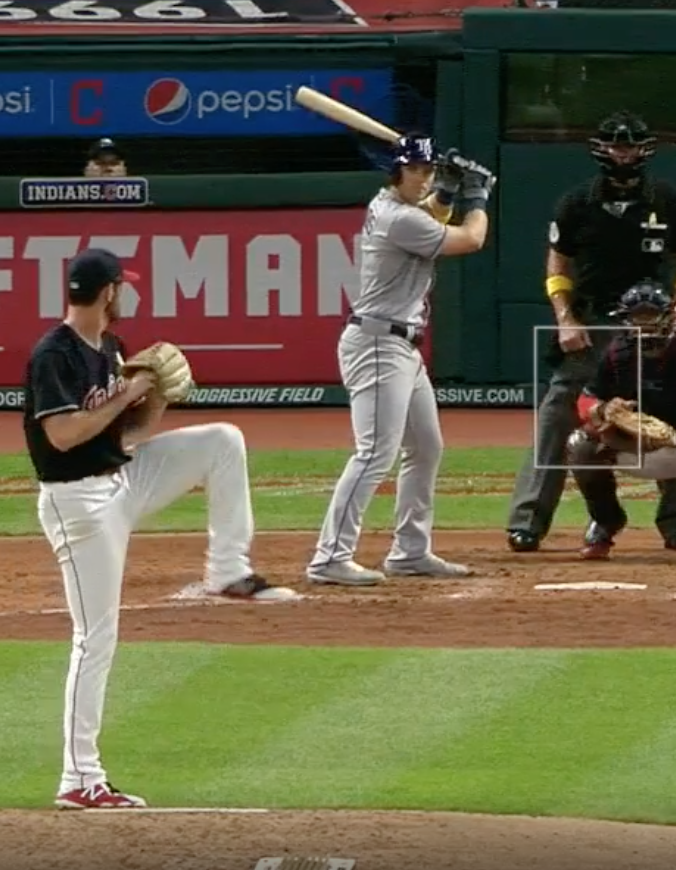When Cleveland traded for Jake Bauers in 2018, it was easy to see why they were buying. Bauers was the #45 prospect on the Baseball America Top 100 coming into 2018 and while he struggled in his first taste of MLB, there was plenty of reason for optimism.
His minor league career showed consistently excellent plate discipline – walk rates regularly greater than 10%, strikeout rates regularly in the mid-teens – leading to excellent on-base skills, despite lackluster power numbers. Cleveland, who has shown a preference for guys who control the zone and make contact, was an un-surprising team to take a shot on unlocking more power from Bauers.
Two years later, Bauers entered the 2020-21 off-season in a very different place. Years removed from that prospect pedigree, Bauers spent the entire 60-game 2020 season at the alternate site. In the process, Cleveland burned his last option.
So as 2021 opens, Bauers is down to his last chance in Cleveland. He “won” (more on that later) the 1B job in camp over Bobby Bradley, and he is going to get a shot to prove he belongs – but if he doesn’t prove it and prove it fast, he’ll find himself looking for a new home.
What Went Right
The short answer is, “not a lot.” But it isn’t nothing either, so we shouldn’t ignore it. Bauers, in 811 career PA, has a 12.2% walk rate. Among 183 players with 800+ PA in 2018-19, Bauers was tied for the 28th best walk rate. And tied with Paul Goldschmidt, of all people.
That’s pretty good plate-discipline company. Bauers had a reputation as a guy who could control the zone and draw a walk and he did just that. He avoided swinging at bad pitches, with a 25% chase rate that was 28th best out of those 183 players. He had the 40th lowest z-swing, as well. He was supposed to be patient and he was.
So. We’ve covered that.
What Went Wrong
When you are as patient as Bauers, you are going to take a high number of called strikes – and sure enough, his 18.4% called strike rate was tied for 37th among those 183 players. If you are taking that many called strikes and being that patient, you need to make contact when you do swing or you need to make hard contact when you make contact or both.
Of those 183 players, 50 had a called strike rate at or above 18%, including Bauers 18.4%. Of those 50, 31 had a wRC+ of 100 or greater, meaning they were an average or better hitter over 2018-19. Those 31 hitters all either make a lot of contact (contact rate over 80%, top 60 of the 183 players mentioned above) or made at least semi-regular hard contact (hard-hit rate over 38%, top 97 of the 183) or both. Only three had an average exit velocity below 88 mph (bottom 66 of the 183).
Bauers had a 75.7% contact rate (118th of the 183), 32.2% hard-hit rate (150th), and an 87.9 average EV (128th). Bauers was patient but when he did take the bat off his shoulder, not much good happened.
You can get away with a lot of called strikes if you make a lot of contact (Jorge Polanco had an 18.5% called-strike rate and just a 31.3% hard-hit rate, but an 84.2% contact rate, posting a 117 wRC+). You can get away with a lot of called strikes and limited contact if you crush the ball (Max Muncy had a 19.5% called strike rate and just a 73.2% contact rate, but 44.2% hard-hit rate on his way to a 147 wRC+).
But you can’t take a bunch of strikes and have limited, weak contact. That, unfortunately for Bauers, is where he has been living in his brief MLB career.
The result is pretty predictable. While Bauers walks plenty, his 27.0% strikeout rate (20th out of 183) isn’t going to fly for a guy who doesn’t bring elite power. Over 2018-19, only two players managed to strikeout over 27% of the time and post an ISO under .190 while still being an above-average hitter – Willy Adames (27.3% strikeout rate, .151 ISO, 102 wRC+) and Wil Myers (31.5%, .185, 101). What helped those to barely eke out above-average production? High BABIPs – .340 for Adames, .336 for Myers.
Bauers, without high contact rates or impressive power, enters 2021 with a .214/.314/.377 slash line and an 88 wRC+.
What Needs to Change
Strong walk rates are a nice foundation to build on, but Bauers needs to fix at least one of two things – he needs to make more contact or he needs to make better contact. Bauers is attempting to do that by reworking his swing:
2021 OFF SEASON WORK: JAKE BAUERS pic.twitter.com/laqLr67ze6
— Coach Marcelino (@CoachMarcelino) February 8, 2021
It’s hard to see from that video what Bauers is doing, but let’s compare a Bauers swing from 2019 to his recent Spring Training home run.
Here he is late in 2019, one of the last times we saw him in a big-league park:
Here he is last week:
Slowing it down with some stills, there are some clear differences.
Compared to the 2019 swing (red jersey) in 2021 (blue jersey), his hands are much higher. In 2019, they were hidden behind his head and pulled in close to his shoulder, with his back elbow sneaking out behind his helmet.
In 2021, the back elbow isn’t as far back, the hands are further up and out in the open, more over the plate. It’s a bit hard to tell – different camera angles and all – but I think his stance is a bit more open, as well. In 2019, his front foot toes are overlapping his back heel; in 2021, they are not. It also appears his shoulders are more open to the pitcher – he is still pretty closed, but maybe not to the same extreme.
Going back in time, here is a still of a similar point in a swing off Shane Bieber. This is relatively early in his career and likely more similar to what he was doing in the minors when he was such a highly-regarded prospect.
He looks more open, his hands are further out, his back elbow is visible in front of his head. It’s not the same as the Spring Training home run, but it seems he has moved closer to where he was when he was coming up vs. where he was when he last played an MLB game.
Is the Change Working?
To be blunt, we don’t know. And we won’t for a while. But the early results are not particularly encouraging.
Early on, I noted that Bauers “won” the 1B job in Cleveland – that won is in quotes because it’s a stretch to say he won anything this Spring. Bauers had 50 PA in Arizona and he drew 10 walks, which is great, but also kinda exactly what you expect from Bauers. The question is did he make contact and did he make hard contact.
In addition to the 10 walks, Bauers struck out 16 times. In 100 PA, we would be thrilled with 10 walks and 16 K, but in 50 PA that is a 32% strikeout rate and that isn’t good enough.
He hit just that one HR and had a .157 ISO. Going back to those numbers we saw before about patient hitters needing to make contact and make hard contact, neither a 32% strikeout rate nor a .157 ISO are going to carry him to an above-average offensive season unless he gets that .335+ BABIP to go with it.
It’s only 50 PA, and it is only Spring Training, but the concerning thing here is that Bauers looks – even with the changes – like the same guy we have seen for 811 MLB plate appearances. Lots of walks, too many strikeouts, not enough loud contact.
Perhaps even more concerning, this isn’t that different from who he was in the minors. That top-50 prospect we talked about earlier? He never hit more than 16 HR in a year. Those 16 came across Triple-A and MLB in 2018.
Prior to that, he had years of 13 and 14, but no more. In 2019, he had 15, again between Triple-A and MLB. His minor league ISOs were nothing to write home about, either. He never broke .180 until he had a .183 in 2018 in MLB and then .180 in 103 Triple-A PAs in 2019. As we saw earlier, with the types of strikeouts he has been posting, anything under .190 makes it hard to see much success coming.
If you are looking for reasons for optimism, there might be one thing to point to. We have limited Statcast data on Bauers – a total of four batted balls put into play including both Spring Training and the regular season – and that might be our first glance at something a little interesting if you can call four batted balls interesting.
Bauers, who has a career hard-hit rate of 32.4% and a career average EV of 87.9, has hit all four balls over 90 mph – 105.2 on the Spring HR, 95.0 on his Opening Day pop up, 93.1 and 90.5 on two others outs on balls in play in Arizona. That’s a 96.0 average exit velocity and a 50% hard-hit rate. On four batted balls, remember, but at least it’s something that looks positive.
This doesn’t mean Bauers is done. He went 0-1 as a pinch hitter on Opening Day and figures to get a start at 1B today, with a right-hander on the mound for Detroit. Cleveland will want to give him ample time to prove himself, as moving on means exposing him to waivers, rather than letting him get his retooled swing into shape in the minors.
As Bauers gets those PA against righties, I’ll be closely watching his contact rates and contact quality. If those four batted balls over 90 mph are the start of something new, Bauers might still strike out too much, but at least he’ll do damage when he makes contact, and that might work out.
The walks will be there and, more than likely, he’ll post a decent on-base percentage. But if he isn’t making a lot of contact or loud contact – or both – it won’t be enough.


